Nonlinear Thermo-Structural Analysis of Lightweight Concrete and Steel Decking Composite Slabs under Fire Conditions: Numerical and Experimental Comparison
Abstract
:1. Introduction
2. Experimental Study
2.1. Description of the Slab Types
2.2. Testing Procedure
2.3. Experimental Results
2.3.1. Thermal Results
2.3.2. Mechanical Results
3. Thermo-Structural Numerical Model
3.1. Nonlinear Thermal FEM Model
Steel–Concrete Interaction
3.2. Nonlinear Structural FE Model
3.3. Numerical Solution Schemes
3.4. Numerical Results
4. Numerical and Experimental Comparison
4.1. Thermal Comparison
4.2. Structural Comparison
5. Conclusions
- The measured temperatures on the steel decking profile are lower than the ISO 834 curve. This phenomenon is due to free water vaporization, and the debonding effect that introduces an air gap between the concrete and the steel decking profile.
- Concrete contains water that vaporizes at temperatures above 100 °C. In this work, the measured temperatures on the concrete show a non-constant increase and a plateau at 100 °C. This is caused by the vaporization process of the free water, which is an endothermic reaction and consumes energy, slowing down the heating up of the concrete.
- The thermal properties (thermal conductivity, specific heat) of concrete, the moisture content and the porosity affect the increase in temperature in the slab. Furthermore, the complex heat transfer phenomenon due to the vaporization in LWC slabs causes a greater distortion. This effect is mainly due to the porosity of the material, which is directly related to its moisture content.
- The higher moisture content of LWC composite slabs causes the measured temperature in LWC composite slabs to be lower than NC. Therefore, LWC composite slabs have lower heat transfer under fire conditions than NC.
- The insulation criteria of the composite slab and the influence of the trapezoidal shape is studied on the non-exposed surface. The temperature variation between the thinner and thicker part is lower than 15 °C. Therefore, based on the temperature measured, the insulation and integrity criteria are met for all the samples.
- The experimental results show that there is debonding between the steel decking and the concrete slab. This phenomenon introduces a gap between both materials; thus, the heat transfer in the composite slab is influenced and the pressure in the internal concrete pores is reduced. Spalling is not observed in any of the tests carried out. It can be concluded that the steel decking prevents direct fire exposure to the concrete core and acts as a barrier to the expansive effect of spalling on this type of structural element.
- In general, the vertical deflection under fire conditions has three stages. The first stage is caused by the thermal expansion and reduction of the mechanical properties of steel. The second stage involves the load transfer to the concrete. Finally, the slab collapses.
- Although the deflection measured in all the slabs is very similar, the load-bearing capacity (R30) is reached only for LWC-3 and NC. It is observed that the structural behavior of the lighter slabs does not accomplish the minimum load-bearing capacity of 30 min. To achieve the load-bearing capacity, two possible solutions can be used. First, composite slabs should be reinforced to ensure the minimum value of R30 is reached. Second, active fire protection elements can be used on the trapezoidal steel decking so that the temperature increase in the steel decking is slowed down and its mechanical properties are maintained for longer. A combination of the two solutions is also possible.
- ANSYS Workbench Mechanical can link a thermal analysis to a structural analysis, sharing Engineering Data, Geometry and Model directly. When directly linked, bodies in the structural model cannot be suppressed independently of the thermal analysis. When the same mesh is used, temperature mapping is usually simple. If the thermal model has finite contact conductance for a contact pair, a temperature drop can occur across the pair, and users should ensure that temperatures from one side of a contact pair do not end up on the other side. An identical mesh helps to avoid convergence issues.
- A bonded contact with variable thermal properties was used in the numerical model because the embossments of the steel decking significantly reduce the sliding between the concrete and the steel decking. As shown in Section 3.1, numerical and experimental results are in good agreement.
- The numerical models developed simulate the effect of the endothermic process of free water vaporization, showing slope changes around 100 ºC. At the end of the FEM model, around 1500 s, there is some divergence between experimental and numerical results. These differences could be due to the debonding effect that occurs in the experimental tests.
- The definition of a thermal contact conductance coefficient as a function of temperature is needed to obtain a good agreement between numerical and experimental results.
- The mechanical properties must be defined as a function of temperature. This nonlinearity makes it possible to simulate structural behavior under fire conditions.
- The validation of the numerical models is possible by defining thermal expansion. The correct definition of this parameter plays a fundamental role in ensuring that the coupled models follow the experimental evolution. The use of the values indicated in Eurocode 4 part 1–2 causes errors. These errors include a 30% discrepancy between experimental and numerical data, as well as the non-convergence of the model.
- Differences between experimental and numerical temperatures at the thick part are attributed to the convection coefficient for the web of the steel decking. This value, taken from a previous work [42], does not take into account the vaporization phenomenon at the interface between steel decking and concrete. Future research works should be expanded to properly define this convection coefficient.
- The use of different static structural analyses with a transient thermal analysis makes it possible to simulate the experimental structural behavior of composite slabs under fire conditions. The numerical model presented in this work is capable of accurately reproducing the structural behavior of the composite slabs after 500 s of testing, when the debonding has already happened. Until then, there are significant discrepancies between the experimental and numerical results, due to the complexity of the thermal and mechanical phenomena that occur in this phase.
- In general, the proposed values of the thermal contact conductance coefficient provide good agreement with experimental results and satisfactorily simulated the debonding effect. However, the numerical results include a significant discrepancy between experimental and numerical data up to 500 s of normalized test time. Future works should study new coefficients as mentioned by Piloto et al. [24].
Author Contributions
Funding
Institutional Review Board Statement
Informed Consent Statement
Acknowledgments
Conflicts of Interest
Nomenclature
| Acronyms | |
| APDL | ANSYS parametric design language |
| CONTA174 | Surface to surface contact element (ANSYS software library) |
| ECC | Expanded clay coarse |
| ECF | Expanded clay fine |
| FEM | Finite element method |
| I | Insulation |
| L | Load-bearing capacity |
| LCA | Life-cycle assessment |
| LWC | Lightweight concrete |
| NIST | National Institute of Standards and Technology |
| NC | Normal concrete |
| R | Integrity |
| SHELL131 | 4-node shell heat transfer element (ANSYS software library) |
| SHELL281 | 8-node shell element (ANSYS software library) |
| SOLID90 | 20-node solid heat transfer element (ANSYS software library) |
| SOLID186 | 20-node solid element (ANSYS software library) |
| TARGE170 | Surface to surface contact element (ANSYS software library) |
| X | Transversal direction |
| Z | Longitudinal direction |
| Symbols | |
| Temperature rate | |
| Deformation caused by the micro-cracks produced by the composition of the concrete | |
| Deformation caused by shrinkage | |
| Deformation measured experimentally | |
| Effective thermal deformation | |
| Specific heat (kJ/kgK) | |
| Compression strength (MPa) | |
| Thermal conductivity of LWC at ambient temperature (W/mK) | |
| Nonlinear thermal conductivity of LWC based on Eurocode 4 (W/mK) | |
| Thermal contact conductance coefficient (W/m2K) | |
| Load-bearing capacity criterion (mm) | |
| Heat flux per unit area (W/m2) | |
| Greek symbols | |
| Effective thermal expansion coefficient | |
| Temperature (°C) | |
| Temperature of the contact points on the contact surfaces (°C) | |
| Temperature of the contact points on the target surfaces (°C) | |
References
- Ahmed, I.M.; Tsavdaridis, K.D. Life cycle assessment (LCA) and cost (LCC) studies of lightweight composite flooring systems. J. Build. Eng. 2018, 20, 624–633. [Google Scholar] [CrossRef]
- Govindan, K.; Madan Shankar, K.; Kannan, D. Sustainable material selection for construction industry—A hybrid multi criteria decision making approach. Renew. Sustain. Energy Rev. 2016, 55, 1274–1288. [Google Scholar] [CrossRef]
- Sahlol, D.G.; Elbeltagi, E.; Elzoughiby, M.; Elrahman, M.A. Sustainable building materials assessment and selection using system dynamics. J. Build. Eng. 2020, 35, 101978. [Google Scholar] [CrossRef]
- Johnson, R.P.P. Composite Structures of Steel and Concrete, 3rd ed.; John Wiley and Sons Ltd.: Chicester, UK, 2004. [Google Scholar] [CrossRef]
- Abushanab, A.; Alnahhal, W.; Farraj, M. Structural performance and moment redistribution of basalt FRC continuous beams reinforced with basalt FRP bars. Eng. Struct. 2021, 240, 112390. [Google Scholar] [CrossRef]
- Purkiss, J.A. Fire Safety Engineering. In Design of Structures, 2nd ed.; Cambridge University Press: Cambridge, UK, 2007; Volume 53. [Google Scholar] [CrossRef]
- Kan, Y.C.; Chen, L.H.; Yen, T. Mechanical behavior of lightweight concrete steel deck. Constr. Build. Mater. 2013, 42, 78–86. [Google Scholar] [CrossRef]
- Arrayago, I.; Real, E.; Mirambell, E.; Marimon, F.; Ferrer, M. Experimental study on ferritic stainless steel trapezoidal decks for composite slabs in construction stage. Thin-Walled Struct. 2019, 134, 255–267. [Google Scholar] [CrossRef]
- Ahmed, I.M.; Tsavdaridis, K.D. Shear connection of prefabricated slabs with LWC–Part1: Experimental and analytical studies. J. Constr. Steel Res. 2020, 169, 106016. [Google Scholar] [CrossRef]
- Waldmann, D.; May, A.; Thapa, V.B. Influence of the sheet profile design on the composite action of slabs made of lightweight woodchip concrete. Constr. Build. Mater. 2017, 148, 887–899. [Google Scholar] [CrossRef]
- Martínez-Martínez, J.E.; Rabanal, F.P.Á.; Lázaro, M.; Alonso-Martínez, M.; Alvear, D.; del Coz-Díaz, J.J. Assessment of lightweight concrete thermal properties at elevated temperatures. Appl. Sci. 2021, 11, 10023. [Google Scholar] [CrossRef]
- del Coz-Díaz, J.J.; Martínez-Martínez, J.E.; Alonso-Martínez, M.; Rabanal, F.P.Á. Comparative study of LightWeight and Normal Concrete composite slabs behaviour under fire conditions. Eng. Struct. 2020, 207, 110196. [Google Scholar] [CrossRef]
- Jiang, J.; Main, J.A.; Weigand, J.M.; Sadek, F. Reduced-order modeling of composite floor slabs in fire. I: Heat-transfer analysis. J. Struct. Eng. 2020, 146, 04020080. [Google Scholar] [CrossRef]
- Lamont, S.; Usmani, A.S.S.; Drysdale, D.D.D. Heat transfer analysis of the composite slab in the Cardington frame fire tests. Fire Saf. J. 2001, 36, 815–839. [Google Scholar] [CrossRef]
- Pantousa, D.; Mistakidis, E. Advanced Modeling of Composite Slabs with Thin-Walled Steel Sheeting Submitted to Fire. Fire Technol. 2013, 49, 293–327. [Google Scholar] [CrossRef]
- Jiang, J.; Main, J.A.; Sadek, F.H.; Weigand, J.M. Numerical Modeling and Analysis of Heat Transfer in Composite Slabs with Profiled Steel Decking; National Institute of Standards and Technology: Gaithersburg, MD, USA, 2017. [Google Scholar] [CrossRef]
- UNE-EN 1994-1-2; Eurocode 4–Design of Composite Steel and Concrete Structures–Part 1–2: General Rules–Structural Fire Design. AENOR: Madrid, Spain, 2016.
- Piloto, P.A.G.; Prates, L.M.S.; Balsa, C.; Rigobello, R. Numerical simulation of the fire resistance of composite slabs with steel deck. Int. J. Eng. Technol. 2018, 7, 83. [Google Scholar] [CrossRef]
- Sharma, S.; Vaddamani, V.T.; Agarwal, A. Insulation effect of the concrete slab-steel deck interface in fire conditions and its influence on the structural fire behavior of composite floor systems. Fire Saf. J. 2019, 105, 79–91. [Google Scholar] [CrossRef]
- Nguyen, M.P.; Nguyen, T.T.; Tan, K.H. Temperature profile and resistance of flat decking composite slabs in- and post-fire. Fire Saf. J. 2018, 98, 109–119. [Google Scholar] [CrossRef]
- Li, G.-Q.Q.; Zhang, N.; Jiang, J. Experimental investigation on thermal and mechanical behaviour of composite floors exposed to standard fire. Fire Saf. J. 2017, 89, 63–76. [Google Scholar] [CrossRef]
- Bolina, F.; Tutikian, B.; Rodrigues, J.P.C. Thermal analysis of steel decking concrete slabs in case of fire. Fire Saf. J. 2021, 121, 103295. [Google Scholar] [CrossRef]
- Piloto, P.A.; Balsa, C.; Santos, L.M.; Kimura, É.F. Effect of the load level on the resistance of composite slabs with steel decking under fire conditions. J. Fire Sci. 2020, 38, 212–231. [Google Scholar] [CrossRef]
- Filho, M.M.A.; Piloto, P.A.G.; Balsa, C. Thermal Behaviour of Rebars and Steel Deck Components of Composite Slabs under Natural Fire. J. Compos. Sci. 2022, 6, 232. [Google Scholar] [CrossRef]
- UNE-EN 13381-5; Test Methods for Determining the Contribution to the Fire Resistance of Structural Members–Part 5: Applied Protection to Concrete/Profiled Sheet Steel Composite Member. AENOR: Madrid, Spain, 2016.
- UNE-EN 1363-1; Fire Resistance Tests–Part 1: General Requirements. AENOR: Madrid, Spain, 2021.
- UNE-EN ISO 6892-1; Metallic Materials–Tensile Testing–Part 1: Method of Test at Room Temperature (ISO 6892-1:2019). AENOR: Madrid, Spain, 2020.
- UNE-EN 12390-13; Testing Hardened Concrete–Part 13: Determination of Secant Modulus of Elasticity in Compression. AENOR: Madrid, Spain, 2014.
- UNE 83507; Concrete with Fibres. Testing in Compression. AENOR: Madrid, Spain, 2004.
- ISO 834-1; Fire-Resistance Tests-Elements of Building Construction–Part 1: General Requirements. International Organization for Standardization: Geneva, Switzerland, 1999.
- Balsa, C.; Silveira, M.; Mange, V.; Piloto, P.A.G. Modelling the Thermal Effects on Composite Slabs Under Fire Conditions. Computation 2022, 10, 94. [Google Scholar] [CrossRef]
- Thompson, M.; Thompson, J. ANSYS Mechanical APDL for Finite Element Analysis; Butterworth-Heinemann: Oxford, UK, 2017. [Google Scholar]
- Lim, L.; Wade, C. Experimental Fire Tests of Two-Way Concrete Slabs; University of Canterbury School of Engineering: Christchurch, New Zealand, 2002. [Google Scholar]
- Ghojel, J. Experimental and analytical technique for estimating interface thermal conductance in composite structural elements under simulated fire conditions. Exp. Therm. Fluid Sci. 2004, 28, 347–354. [Google Scholar] [CrossRef]
- Espinos, A.; Romero, M.L.; Hospitaler, A. Advanced model for predicting the fire response of concrete filled tubular columns. J. Constr. Steel Res. 2010, 66, 1030–1046. [Google Scholar] [CrossRef]
- Tao, Z.; Ghannam, M. Heat transfer in concrete-filled carbon and stainless steel tubes exposed to fire. Fire Saf. J. 2013, 61, 1–11. [Google Scholar] [CrossRef]
- Rokilan, M.; Mahendran, M. Elevated temperature mechanical properties of cold-rolled steel sheets and cold-formed steel sections. J. Constr. Steel Res. 2019, 167, 105851. [Google Scholar] [CrossRef]
- Alain, M.; Pierre, P. Modelling of Concrete Behaviour at High Temperature; Springer International Publishing: Cham, Switzerland, 2019; Volume 30. [Google Scholar] [CrossRef]
- Kodur, V.; Dwaikat, M.; Fike, R. High-Temperature Properties of Steel for Fire Resistance Modeling of Structures. J. Mater. Civ. Eng. 2010, 22, 423–434. [Google Scholar] [CrossRef]
- Meseguer, Á.G.; Cabré, F.M.; Portero, J.C.A. Jiménez Montoya Hormigón Armado, 15th ed.; GUSTAVO GILI: Barcelona, Spain, 2010. [Google Scholar]
- UNE-EN 1991-1-2; Eurocode 1: Actions on Structures–Part 1–2: General Actions–Actions on Structures Exposed to Fire. AENOR: Madrid, Spain, 2019.
- Jiang, J.; Main, J.A.; Weigand, J.M.; Sadek, F.H. Thermal performance of composite slabs with profiled steel decking exposed to fire effects. Fire Saf. J. 2018, 95, 25–41. [Google Scholar] [CrossRef]


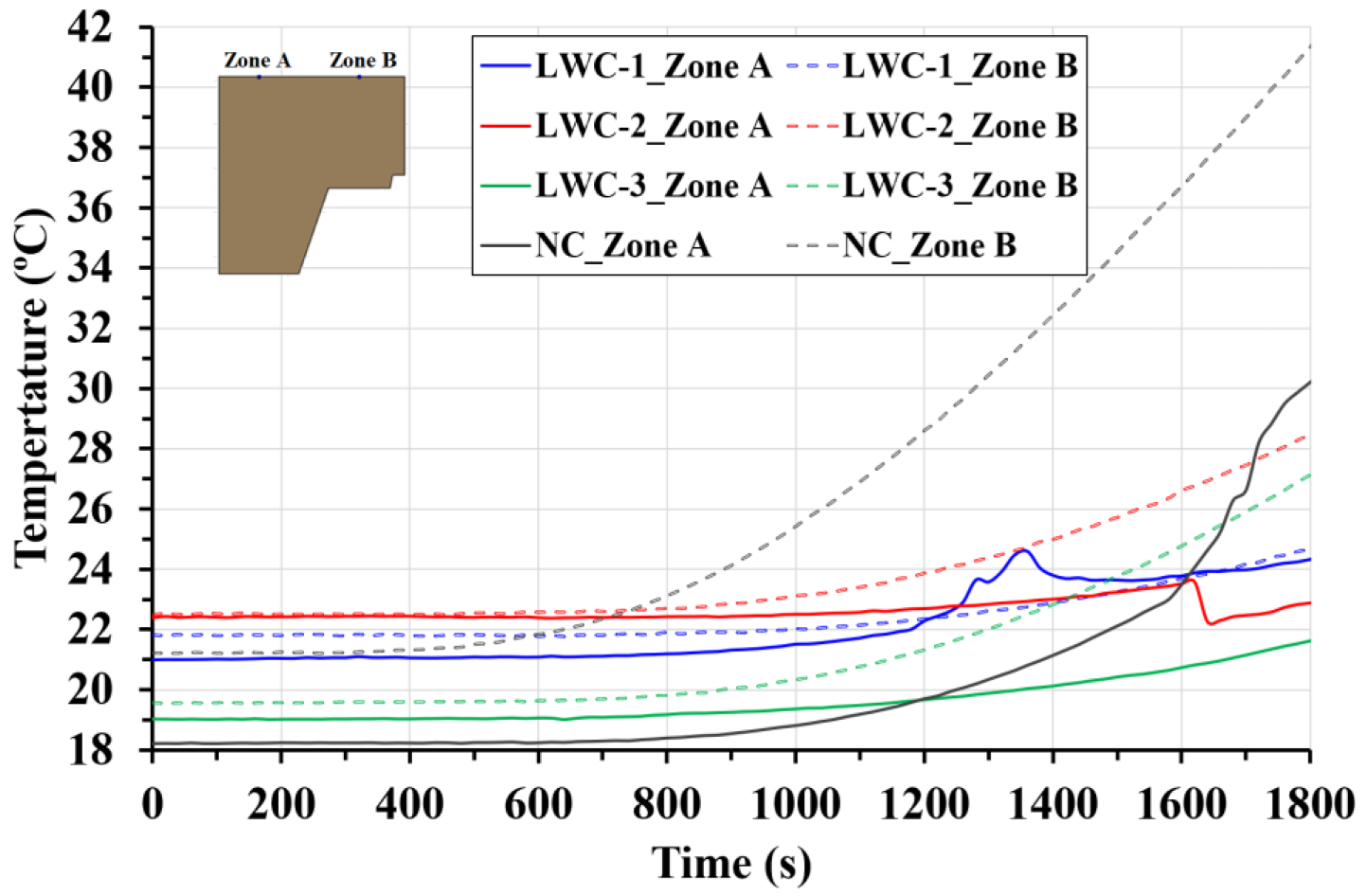

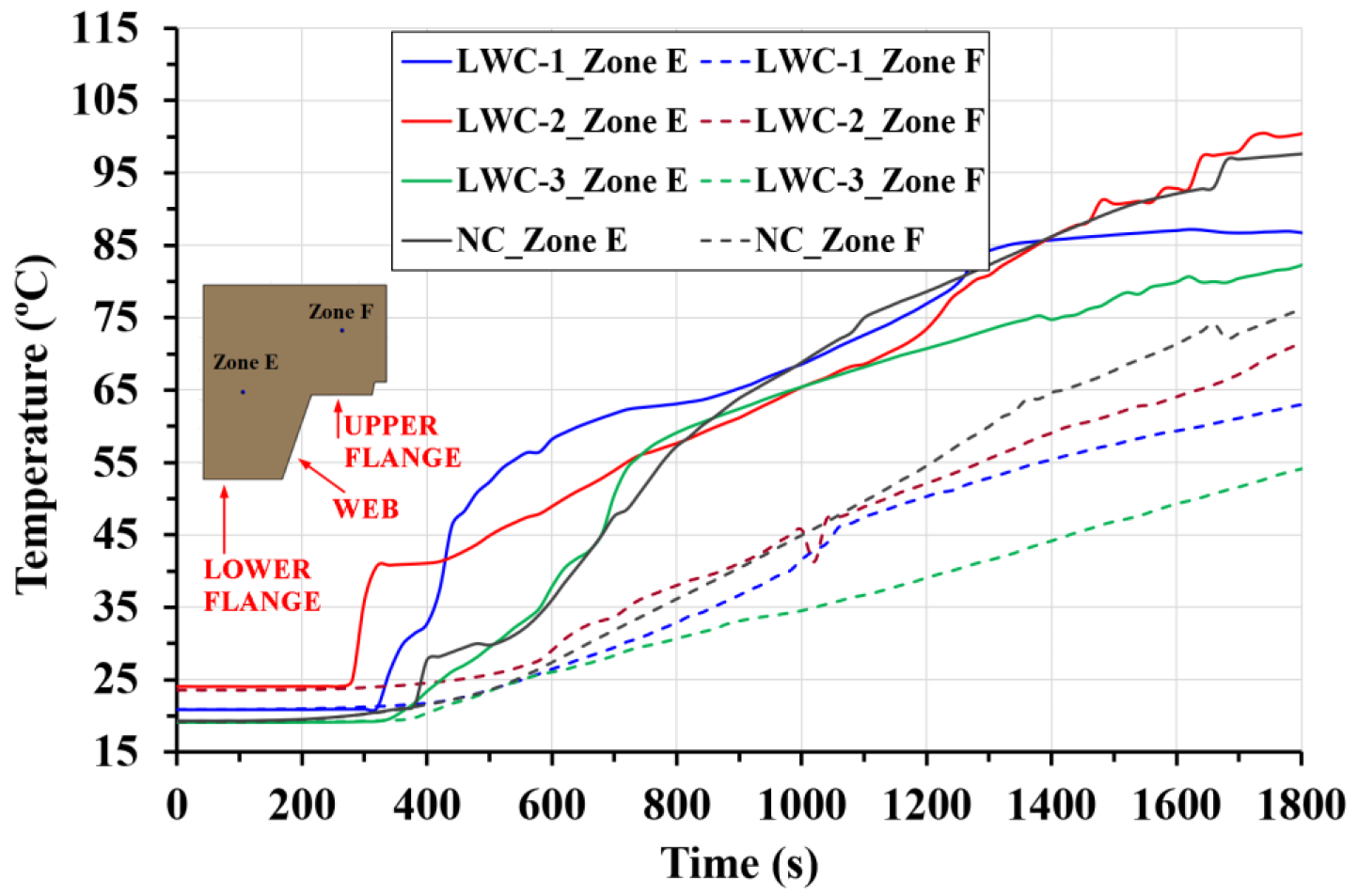

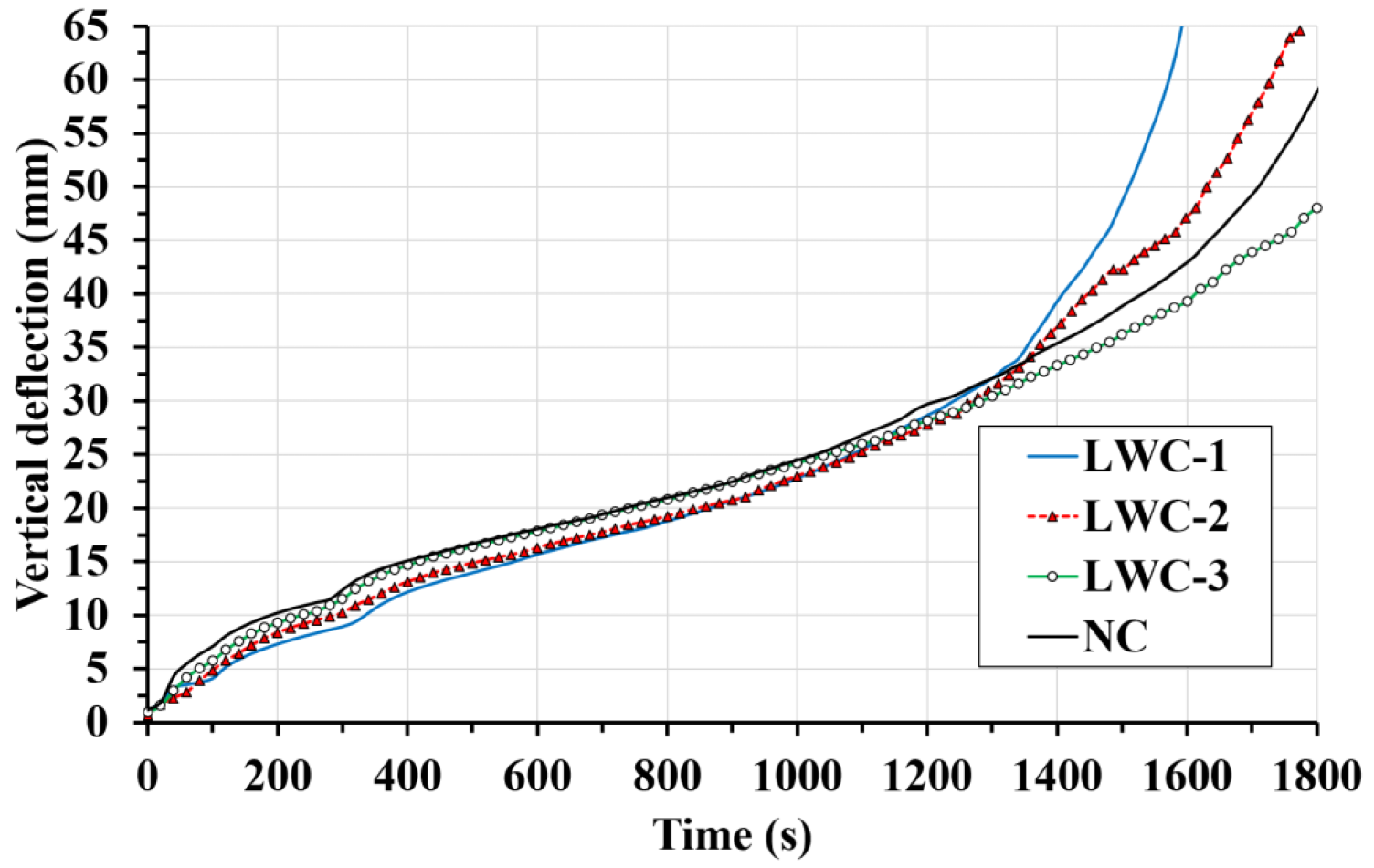
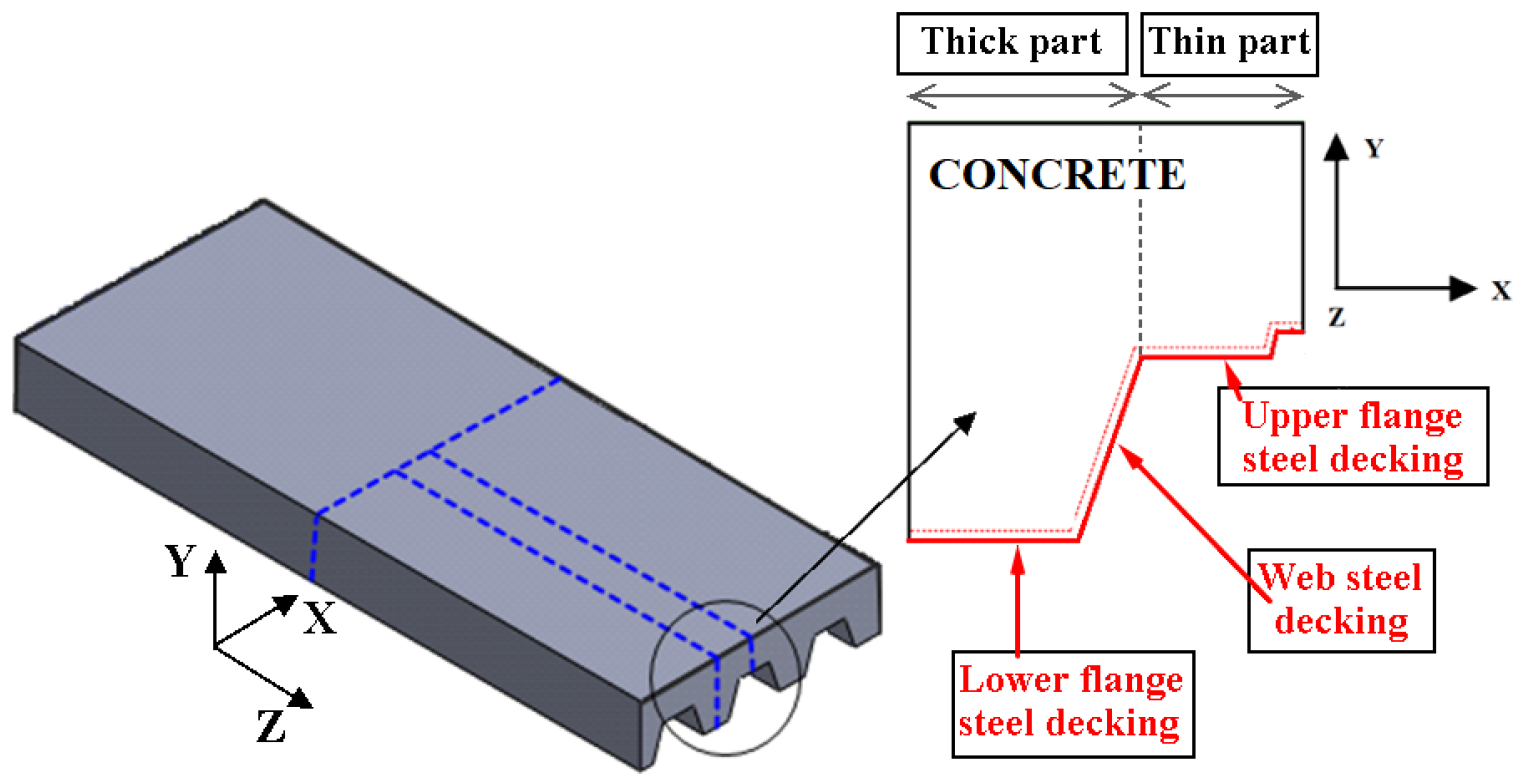
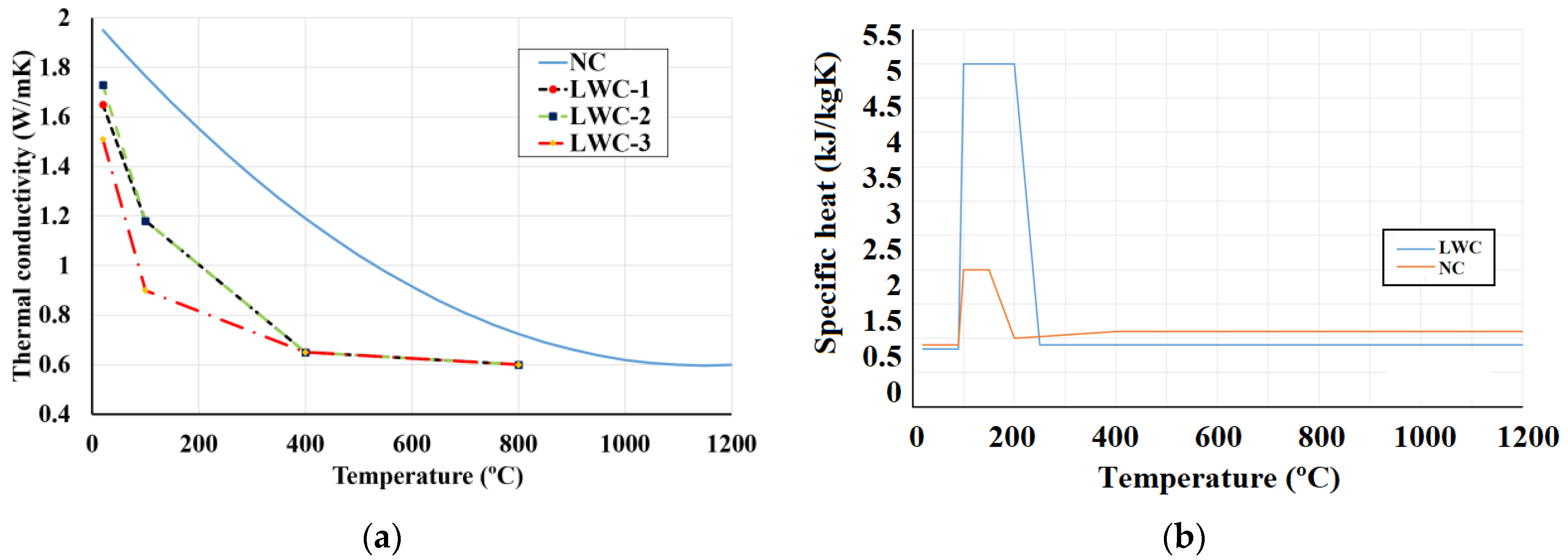
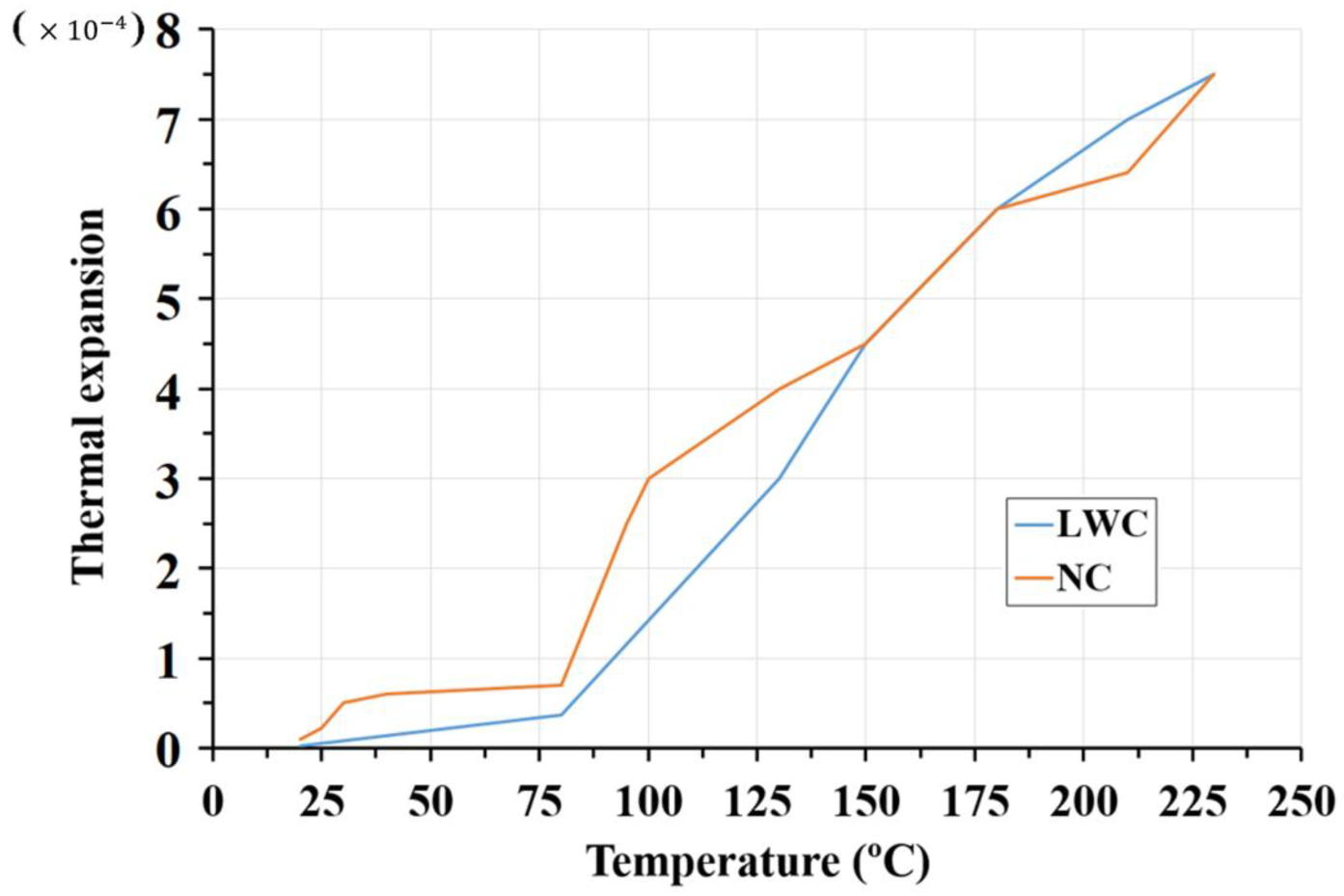


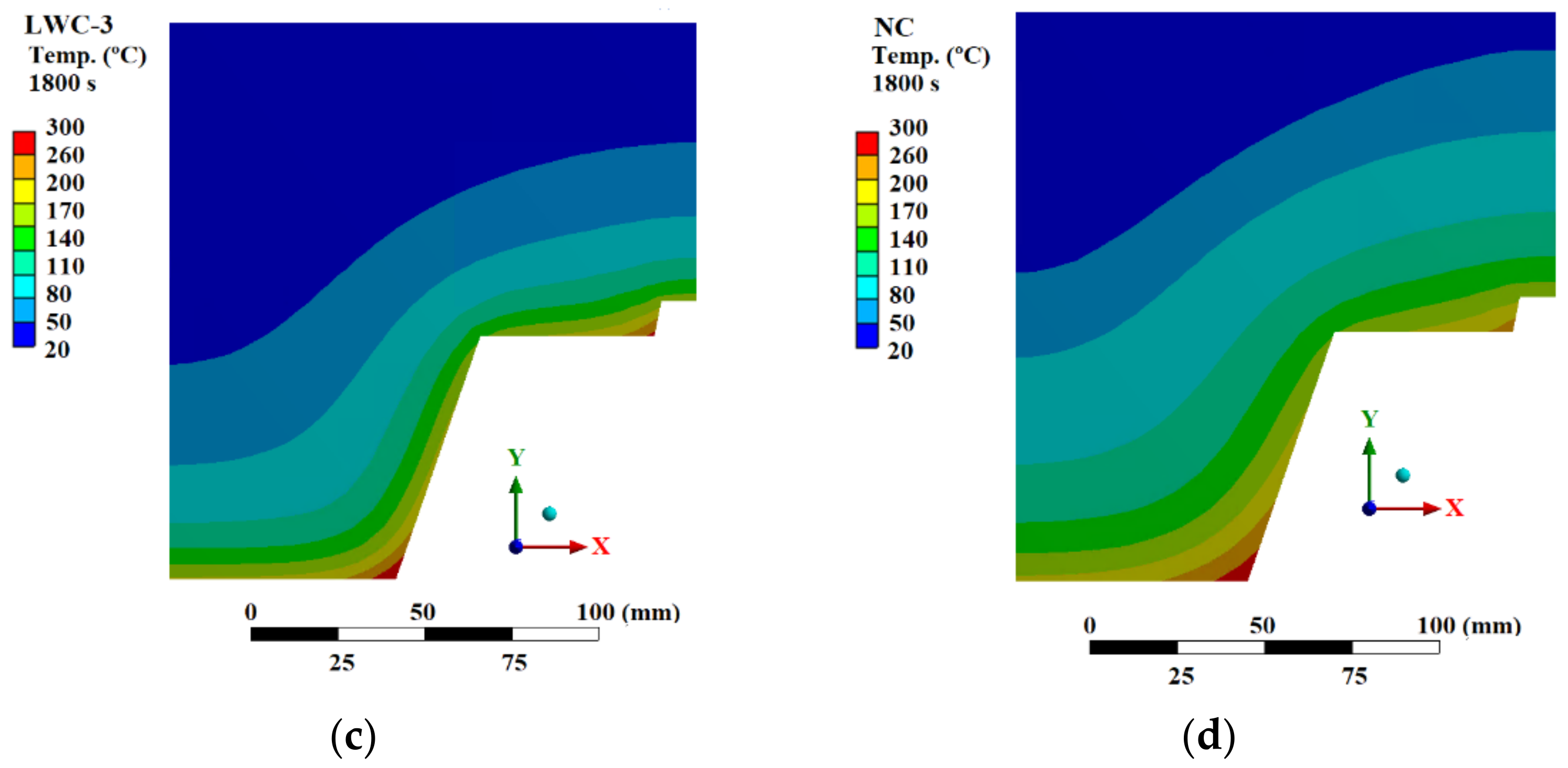
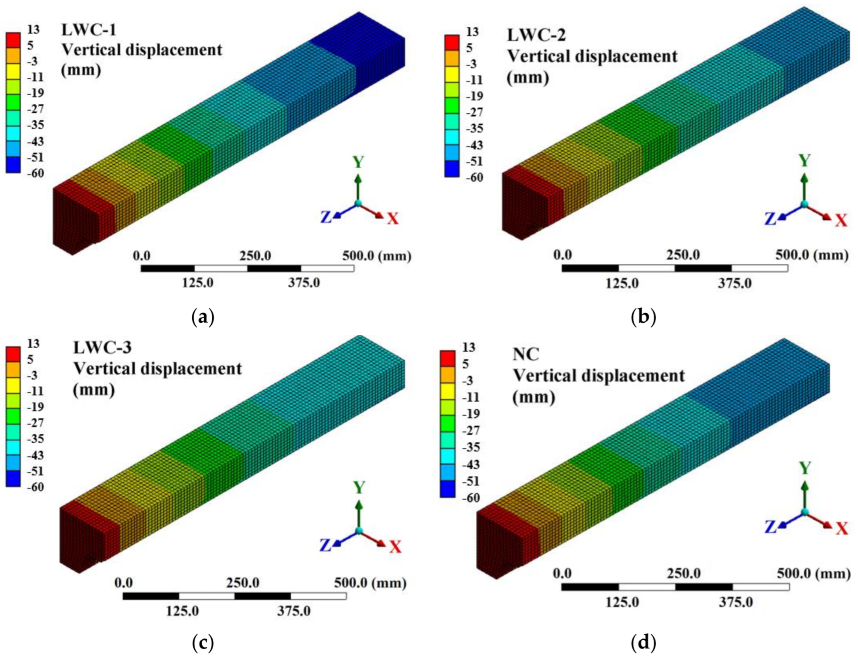
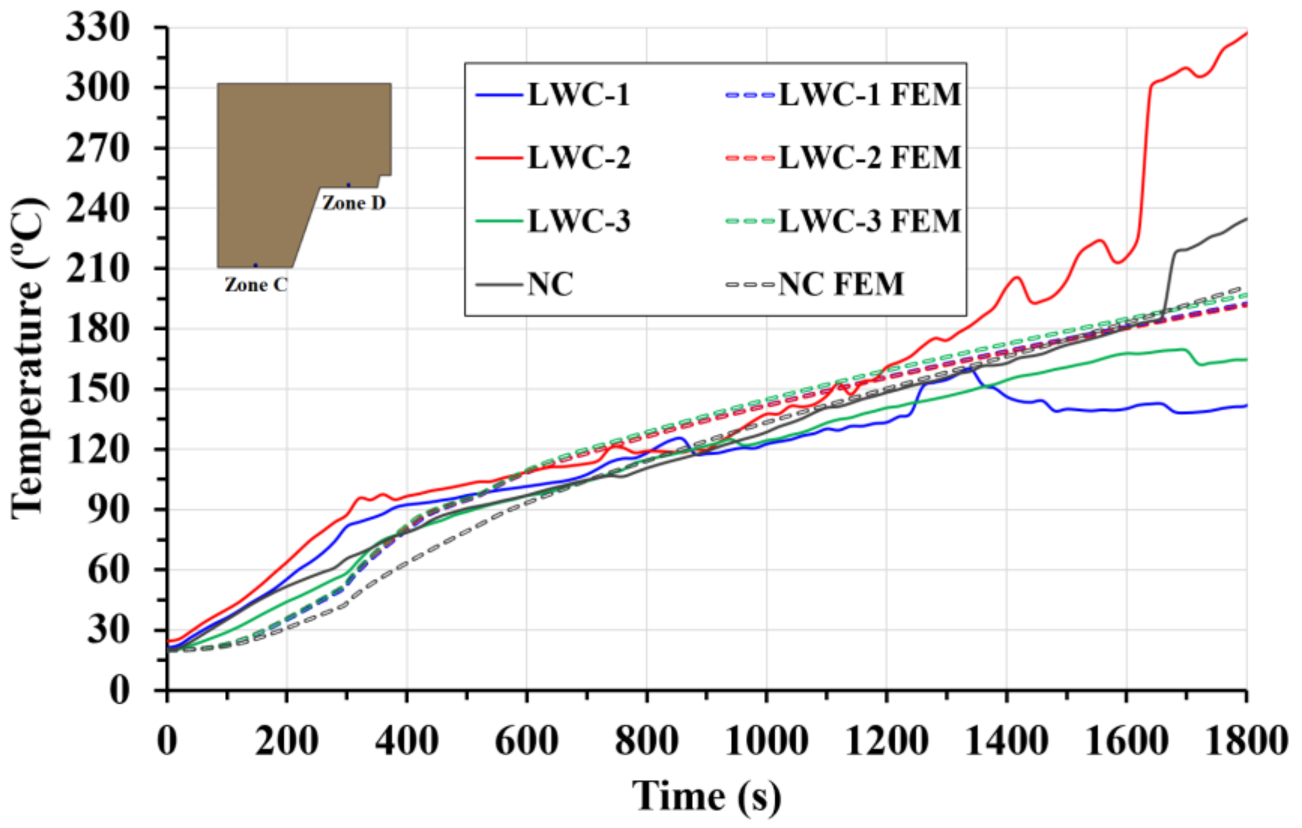

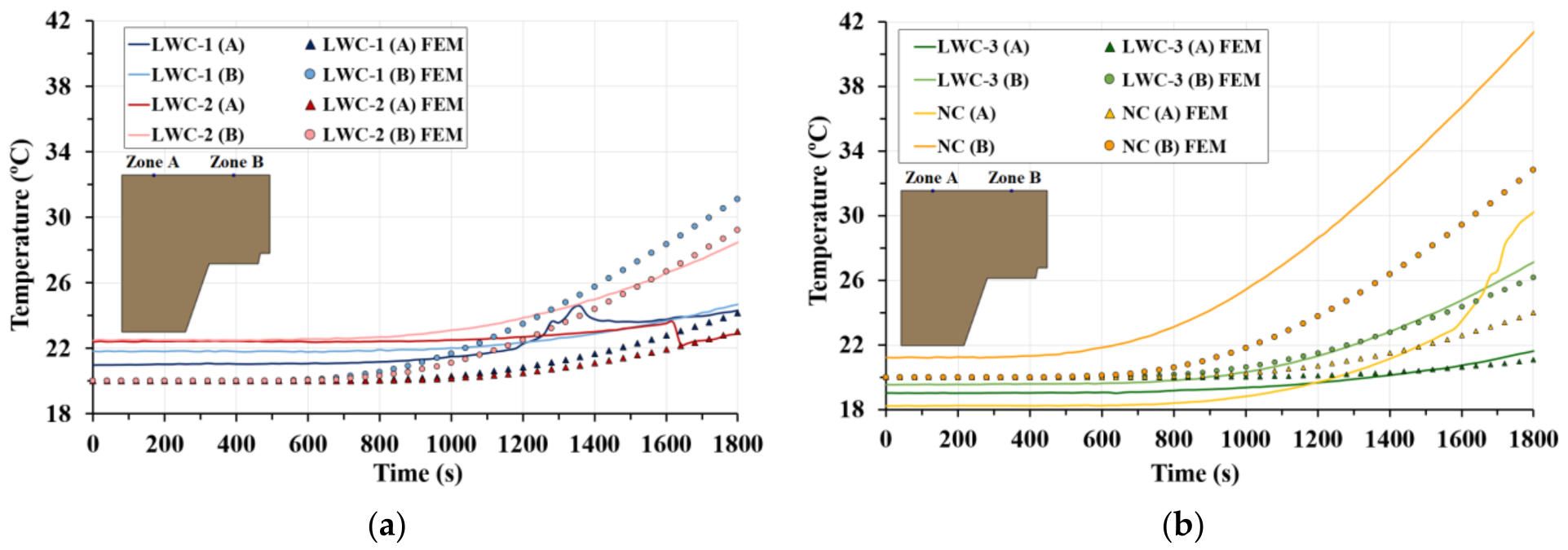

| Elastic Modulus (MPa) | Young’s Modulus (GPa) | Poisson Coefficient | |
|---|---|---|---|
| Average value | 271 | 208 | 0.31 |
| Standard Deviation | 3.51 | 2 | 0 |
| Mixing Compositions | Constituents | ||||
|---|---|---|---|---|---|
| ECF (%) | ECC (%) | Siliceous Aggregate 0/2 (%) | Cement 42.5R (%) | Water (%) | |
| LWC-1 | 5.85 | 6.05 | 40.42 | 32.14 | 15.54 |
| LWC-2 | 5.89 | 4.11 | 44.68 | 30.55 | 14.77 |
| LWC-3 | 3.91 | 4.50 | 44.44 | 31.79 | 15.36 |
| Type | Bulk Density (kg/m3) | Compression Strength (fck, MPa) | Strength Class | Young’s Modulus (GPa) | Thermal Conductivity (k20°C, W/m·K) | Specific Heat (J/kgK) |
|---|---|---|---|---|---|---|
| LWC-1 | 1740 | 25.60 | LC 25/28 | 207 | 1.65 | 950 |
| LWC-2 | 1819 | 28.59 | LC 25/28 | 216 | 1.73 | 840 |
| LWC-3 | 1906 | 30.22 | LC 30/33 | 272 | 1.51 | 850 |
| NC | 2350 | 36.97 | C 30/37 | 457 | 2.52 | 900 |
| Temperature (°C) | kCC (W/m2 K) |
|---|---|
| 20 | 10 |
| 604.5 | 10 |
| 607 | 15 |
| 673.7 | 15 |
| 675.2 | 20 |
| 827.1 | 20 |
| Time (s) | LWC-1 | LWC-2 | LWC-3 | NC |
|---|---|---|---|---|
| 100 | 4.20 | 11.76 | 3.39 | 62.48 |
| 300 | 24.91 | 29.89 | 27.89 | 52.78 |
| 500 | 12.04 | 12.60 | 14.44 | 33.02 |
| 700 | 4.10 | 3.20 | 3.63 | 12.74 |
| 900 | 5.58 | 1.88 | 3.27. | 9.94 |
| 1100 | 8.15 | 3.98 | 2.70 | 7.10 |
| 1300 | 8.86 | 3.24 | 3.67 | 2.05 |
| 1500 | 3.92 | 3.15 | 4.11 | 2.99 |
| 1700 | 17.93 | 6.24 | 0.06 | 0.35 |
Publisher’s Note: MDPI stays neutral with regard to jurisdictional claims in published maps and institutional affiliations. |
© 2022 by the authors. Licensee MDPI, Basel, Switzerland. This article is an open access article distributed under the terms and conditions of the Creative Commons Attribution (CC BY) license (https://creativecommons.org/licenses/by/4.0/).
Share and Cite
Martínez-Martínez, J.E.; Álvarez-Rabanal, F.P.; Alonso-Martínez, M.; del Coz-Díaz, J.J. Nonlinear Thermo-Structural Analysis of Lightweight Concrete and Steel Decking Composite Slabs under Fire Conditions: Numerical and Experimental Comparison. Appl. Sci. 2022, 12, 9306. https://doi.org/10.3390/app12189306
Martínez-Martínez JE, Álvarez-Rabanal FP, Alonso-Martínez M, del Coz-Díaz JJ. Nonlinear Thermo-Structural Analysis of Lightweight Concrete and Steel Decking Composite Slabs under Fire Conditions: Numerical and Experimental Comparison. Applied Sciences. 2022; 12(18):9306. https://doi.org/10.3390/app12189306
Chicago/Turabian StyleMartínez-Martínez, Juan Enrique, Felipe Pedro Álvarez-Rabanal, Mar Alonso-Martínez, and Juan José del Coz-Díaz. 2022. "Nonlinear Thermo-Structural Analysis of Lightweight Concrete and Steel Decking Composite Slabs under Fire Conditions: Numerical and Experimental Comparison" Applied Sciences 12, no. 18: 9306. https://doi.org/10.3390/app12189306






